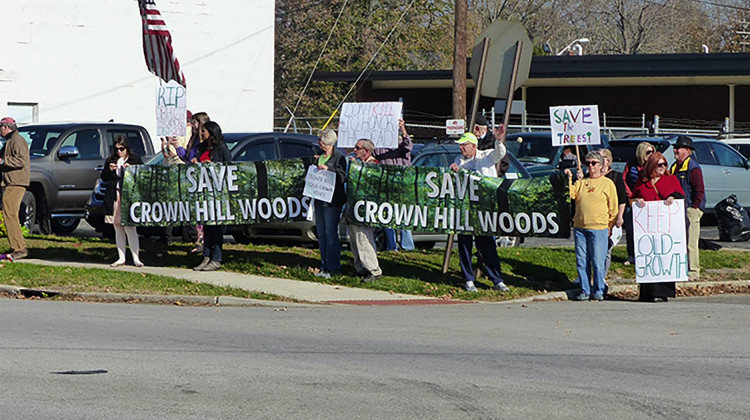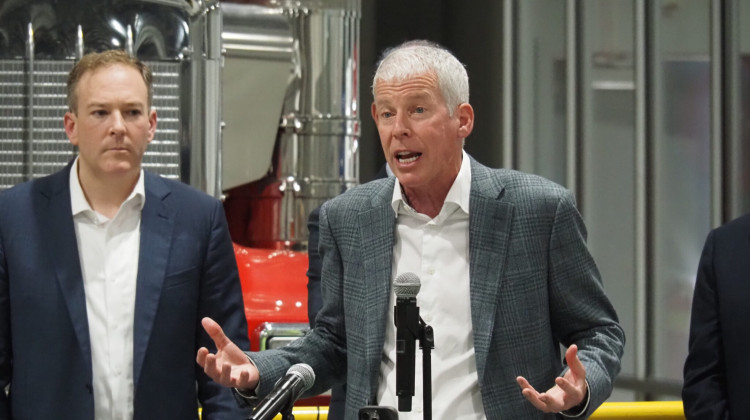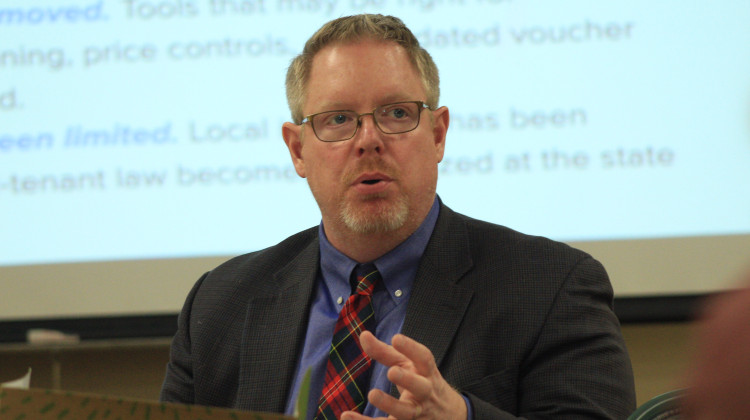
A group led by the Indiana Forest Alliance protested against deforestation at Crown Hill Cemetery in 2017.
FILE: Leigh DeNoon/WFYILESLIE BONILLA MUNIZ - Indianapolis Business Journal
INDIANAPOLIS (AP) — In a forest near West 42nd Street and Clarendon Road, trees tower above bright leaf litter and thousands of scattered, bare branches. Some are older than the state of Indiana, established in 1816.
Five years ago, the U.S. Department of Veterans Affairs nearly leveled 15 acres of this urban forest at Crown Hill Funeral Home and Cemetery, save for a massive public outcry and a last-ditch sit-in that persuaded officials to make other plans.
Today, construction equipment rumbles on another 15 acres of open land to the east, where the VA is building a monument that will eventually hold the ashes of 25,000 veterans.
But the May 2017 victory was a wake-up call for the Indiana Forest Alliance, the organization that led the effort to stop the deforestation at Crown Hill.
“We came to the conclusion that we needed some kind of proactive approach to conserving these places, that we couldn’t just keep trying to save them battle by battle,” Executive Director Jeff Stant told IBJ. “In Crown Hill, the North Woods, we were very fortunate that, at the last minute, the VA blinked. In most cases, (developers) don’t do that.”
The first stage of the group’s new proactive approach is a report that maps all the private forests in Indianapolis that are larger than one acre — there are 4,237 — and evaluates them for their environmental, ecological and social benefits. It then prioritizes the most beneficial.
In all, nearly 32,200 acres of the city’s 38,000 acres of forest — 85% of it — are privately owned, and only a handful of measures are in place to limit their destruction for development.
“They’re all outside the parks. They’re all essentially on a slow-motion chopping block,” Stant said. “It’s just a matter of time—when, not if, they’re going to be developed. We think that a lot of them shouldn’t be. They’re too valuable to the city, its residents and their future as-is, standing.”
The not-for-profit wants policymakers and landowners to step up and help preserve what’s left. But getting results might be a challenge in Indianapolis, a city that has no annual budget for park-land acquisition, is facing increasing development pressure and is confronting dual public safety and infrastructure crises.
These urban forests are about far more than beauty.
The 4.7 million trees in the city’s forests provide an estimated $258 million worth of aesthetic, air-quality, carbon-capture, energy-efficiency and stormwater services every year, according to the report.
At its core is 2013 data from the University of Vermont’s Spatial Analytics Lab identifying all the trees in Marion County and provided to the forest alliance by tree-planting not-for-profit Keep Indianapolis Beautiful. From there, the alliance zoomed in on contiguous forested areas larger than an acre, aggregated dozens of variables and cleaned up the results.
Those forested acres ranked most beneficial are often larger and near waterways. They absorb more stormwater, moderate surface temperatures to a greater degree and have the greatest impact on air quality. The Indiana Forest Alliance estimates that Indianapolis’ forests provide at least $86 million in stormwater protection annually, based on data from a 2016 city management plan for street trees. That’s because their root systems help absorb water and stop runoff.
“The dollar values are not theoretical—they’re real,” said Rae Schnapp, the Indiana Forest Alliance’s conservation director. “If we lose the forests and the services that they’re providing, we’re going to have to pay for stormwater management in other ways. It’s going to cost us money.”
The estimate might even be too conservative, she said, because it’s based on spaced-out trees and forest ecosystems multiply the effects. And the value of centuries-old trees can’t easily be replaced by planting younger, smaller trees, said Bill Kincius, urban forestry manager at the Indianapolis Department of Public Works.
Forests at the top of the ecological rankings are typically old-growth or remnant forests, with greater connectivity to other forests or a larger interior-to-edge ratio. They’re the most biodiverse, able to protect more urban wildlife and are less susceptible to the invasive species that grow along forest edges or take over narrow tree stands, according to the alliance.
The social-benefit rankings prioritized forests in areas with few parks, more youth and schools, and a range of factors that correlate with lower household incomes.
“This is one reason why we looked at forests down to the level of one acre of continuous canopy instead of making a cutoff at 10 acres or even above,” Schnapp said. “We wanted to be really inclusive because we thought that there might be small pockets of woodlands left in areas that have very little green space.”
But those small pockets — and the bigger ones — could be in danger, the alliance argues.
Public trees are protected by the city’s flora ordinance. Their private counterparts, if they’re larger than 18 inches in diameter and of a listed species, could be protected by the city’s heritage tree ordinance. It bans removal of any “heritage tree,” unless the tree in question is dead or dying, of an invasive species, in a certain zoning district—or its location “is preventing development or redevelopment that cannot be physically designed to protect the tree.”
Alternative landscaping plans and tree preservation incentives in the development process can also shield forests, according to a Department of Metropolitan Development spokesperson.
But if the deforestation isn’t part of a development project requiring city approval, landowners can do what they like with their properties.
“I think there’s a balance. I have a hard time telling people that have spent their lives purchasing a property for redevelopment that, all of a sudden, ‘No, you can’t do that,’” Democratic Councilor Jared Evans said, even as he works to preserve 12 acres of wooded land on the west side, near Krannert Park.
“Government—like the city, the state and county, any sort of entity—needs to be playing a bigger role in purchasing these lands and reserves,” Evans said.
Indianapolis’ recent history of park land acquisition is sparse.
The Department of Parks and Recreation, better known as Indy Parks, doesn’t have an annual land-buy budget. It picked up a combined 90 acres for an anticipated $1.8 million in 2021, thanks to flexibility from one-time federal pandemic-relief allotments.
Before that, Indy Parks had purchased just 30 acres of park land since 2001, according to an IBJ review of the City-County Council’s digital legislation database.
And it has to maintain what it owns.
“Something that worries me is, especially from an equity perspective, making sure that we’re consistently maintaining all the parks and that we’re consistently investing in parks, especially ones in areas that haven’t historically had the investment that they need,” said Democratic Councilor John Barth. He led a 2020 sustainability commission that examined, among other topics, Indy Parks and green-space preservation.
“You have to be cautious that your appetite for land acquisition isn’t greater than your ability to maintain and invest in parks,” Barth added.
The city already spends about $235,000 annually, via the Department of Public Works, on care for the trees in its parks, according to Kincius. The city’s nearly 200,000 individual street trees get even more money.
Sports courts and other park infrastructure suck up plenty of maintenance funds, but maintaining forests, once they’re publicly accessible, also costs money.
“We have to carefully manage the coexistence of trees and people in an urban environment,” Kincius said. “As soon as we have amenities and trails in place, and things that we are, by their very nature, inviting people to experience, we have an obligation to … provide periodic maintenance, whatever our resources are able to support.”
“It’s really not an either/or thing,” Kincius added. “Once it’s the city’s responsibility, then there needs to be maintenance dollars committed to it.”
Not everyone’s willing to spend that money. Some, like Republican Councilor Josh Bain, want any discretionary funds funneled into Indianapolis’ protracted struggle with public safety and infrastructure maintenance.
“My starting point is always that, any additional money that we have right now, it probably needs to be going to those two areas,” Bain said. “Should they have something that actually ends up bringing in additional revenue or balances out over the future of our city, then I could be open to exploring that.”
City officials, Bain added, might have to find “creative ways” to finance forest preservation.
Strategies used in other states—like taxes on real estate transfers, utilities or prepared meals—might not translate in Indiana, which has strict controls on where tax dollars go and doesn’t have traditional ballot initiatives or referendums to direct spending. But there are options, according to the Indiana Forest Alliance report.
It offers an exploration of forest-protecting land uses, through which forests could become part of public parks or private conservation areas, act as buffers for flooding from the White River and other local waterways or serve as wildlife protection areas eligible for federal funding.
The report suggests that stormwater-related entities like the Department of Public Works or Citizens Energy Group look into forest acquisition as a stormwater-management measure. Representatives of both affirmed work with planting trees, and interest in engineered solutions involving nature, but said forests weren’t necessarily part of their stormwater strategies.
Conservation easements, in which landowners agree to sell or donate certain rights to a property, are another option, as is funding from the U.S. Land and Water Conservation Fund. But money, again, is a problem—to pay for easements or to pony up the 50% match required by the federal assistance program.
Barth even floated a specialized tax-increment-financing district to capture incremental increases in property value in an area near a park and put the funds back into the land.
Carbon offsets are an emerging alternative. Forest owners could sign onto for-profit or not-for-profit initiatives, like the Natural Capital Exchange or City Forest Credits, to sell carbon-offset credits for maintaining forests or planting trees. Pennsylvania has even created its own program to aggregate small forests for eligibility in carbon-offset credits, and several U.S. cities have used credit proceeds to fund city acquisition of forested land.
“Seattle’s done work there, Austin has done work there and a few others,” Barth said. “My take from the initial research I’ve done is that it’s not going to generate dollars in the amount that we need, but it’s a piece of the pie.”
Indiana has also ventured into carbon sequestration. Senate Bill 373 considered during the 2021 legislative session would have created a voluntary, state-sponsored carbon market in Indiana that allowed companies to pay to make up for their emissions. Some companies already do, but there’s no formal market. The bill was stripped and amended to require a study of a carbon credit market.
“Carbon storage is something that really interests me and something that the state’s really been looking at for the past few years,” Bain said. “It’s really interesting. And I don’t think we should be relying on all these underdeveloped foreign countries to keep their forests and everything while we get to reap all the benefits” of development.
“I’m really just trying to look at: What are the opportunities that the city has to look at creating creative sources of revenue that would be targeted directly at parks and green-space preservation?” Barth said. “That wouldn’t necessarily be a tax increase.”
Barth, who led the temporary sustainability commission, spearheaded the establishment of a permanent environmental sustainability committee. Membership hasn’t officially been settled yet, but Barth has big plans.
The Forest Alliance is set to present its findings at a meeting in late February, he said, and the report itself will be used as a “lay of the land.”
And while the city’s part-time councilors most often vet proposals dreamed up by a range of city agencies, Barth wants the committee to be a source of new ideas.
“My hope is that, actually, this committee will help generate proposals that will ultimately go to the council,” he said. “I see this more as a solution-oriented group that’s going to be presenting options.”
Other councilors say the report could realign priorities across the board toward forest preservation.
“In that balance (between development and forest preservation), it’s verbalizing it, making it a priority as a city and letting our business industry know that this is a priority of ours,” Evans said.
“Once they establish that the council has this perspective, then the zoning board and the (Metropolitan Development Commission) adopt those perspectives as well,” said Democratic Council Vice President Zach Adamson. “And so the report does sort of create that template in advance, before you actually have those instances come up. We’re establishing a precedent, basically.”
For the Indiana Forest Alliance, what counts is action.
“That’s the essence of the issue here, is having the will to follow through on the multitude of plans the city has developed in the last decade that all say forest conservation is important,” Stant said. “The city … has plenty of vision. It just has no will—or can’t afford to have that will.”
Source: Indianapolis Business Journal
 DONATE
DONATE






 Support WFYI. We can't do it without you.
Support WFYI. We can't do it without you.